War memorial

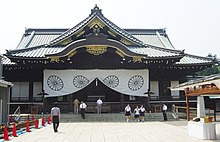
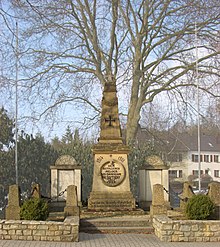
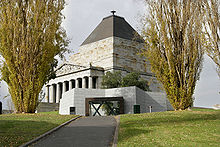
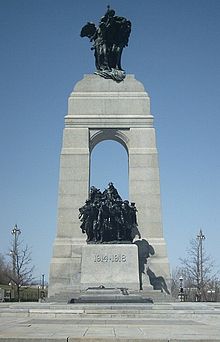


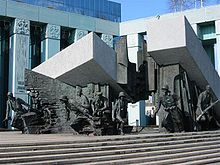
A war memorial is a building, monument, statue or other edifice to celebrate a war or victory, or (predominating in modern times) to commemorate those who died or were injured in war.
Symbolism
Historic usage
For most of human history war memorials were erected to commemorate great victories and remembering the dead was a secondary concern. Indeed in Napoleon's day the dead were shoveled into mass, unmarked graves. The Arc de Triomphe or Nelson's Column contain no names of those killed.
Modern usage
In modern times the main intent of war memorials is not to glorify war, but to honour those who have died. Sometimes, as in the case of the Warsaw Genuflection of Willy Brandt, they may also serve as focal points of increasing understanding between previous enemies.
Using modern technology an international project is currently archiving all war graves and memorials to create a virtual memorial (see The British War Memorial Project for further details).
History
World War I
During the First World War, many nations saw massive devastation and loss of life. In response, most cities in the countries involved in the conflict erected memorials, and the memorials in smaller villages and towns often listed the names of each local soldier who had been killed. Massive monuments commemorating thousands of dead with no identified war grave, such as the Menin Gate at Ypres and the Thiepval memorial on the Somme, were also constructed.
World War II and later
In many cases, the World War I memorials were later extended to also show the names of locals who died in the Second World War. Since that time memorials to the dead in other conflicts such as the Second World War and the Vietnam War have also noted individual contributions, at least in the West. In the Soviet Union, China, Japan and other nations, memorials remained communalistic with long lists of names being far rarer.
Types
- A war memorial can be an entire building, often containing a museum, or just a simple plaque. Many war memorials take the form of a monument or statue, and serve as a meeting place for Memorial Day services. As such, they are often found near the centre of town, or contained in a park or plaza to allow easy public access.
- Many war memorials bear plaques listing the names of those that died in battle. Sometimes these lists can be very long. Some war memorials are dedicated to a specific battle, while others are more general in nature and bear inscriptions listing various theatres of war.
- Many war memorials have epitaphs relating to the unit, battle or war they commemorate. For example an epitaph which adorns numerous memorials in Commonwealth countries is "The Ode" by Laurence Binyon:
- They shall grow not old, as we that are left grow old.
- Age shall not weary them, nor the years condemn.
- At the going down of the sun and in the morning
- We will remember them.
- The Memorial Arch at the Royal Military College of Canada, which remembers ex-cadets who died on military service includes lines of Rupert Brooke's poem, The Dead:
- Blow out, you bugles, over the rich Dead.
- There are none of these so lonely and poor of old,
- but dying has made us rarer gifts than gold.
- The granite slab at the Collège militaire royal de Saint-Jean, which is a World War II War Memorial, which remembers ex-cadets who died on military service, includes the Bible 2 Timothy 4:6-8 (King James Version) quote,
- I have fought the good fight,
- I have finished my course,
- I have kept the faith.
- The Kohima Epitaph which is on the World War II War Memorial for the Allied fallen at the Battle of Kohima says:
- When You Go Home, Tell Them Of Us And Say,
- For Their Tomorrow, We Gave Our Today
- The Memorial Flag of the Royal Military College of Canada consisted of a Union Jack on a backgound adorned with 1100 green maple leaves bearing name of ex-cadets who served in war. The red maple leaves in centre memorialized cadets who made the supreme sacrifice.
- The Memorial stairway in the administration building of Royal Military College of Canada is lined with paintings of ex-cadets who died on military service.
In cemeteries
Many cemeteries tended by the Commonwealth War Graves Commission have an identical war memorial called the Cross of Sacrifice designed by Sir Reginald Blomfield that varies in height from 4.5m to 9m depending on the size of the cemetery. If there are one thousand or more burials, a Commonwealth cemetery will contain a Stone of Remembrance, designed by Sir Edwin Lutyens with words from Ecclesiasticus: "Their name liveth for evermore"; all the Stones of Remembrance are 3.5m long and 1.5m high with three steps leading up to them.
Arlington National Cemetery has a Canadian Cross of Sacrifice with the names of all the citizens of the USA who lost their lives fighting in the Canadian forces during the Korean War and two World Wars.
Controversy
Unsurprisingly, war memorials can be politically controversial. A notable example is the Yasukuni Shrine in Japan, where a number of convicted World War II war criminals are interred. Chinese and Korean representatives have often protested against the visits of Japanese politicians to the shrine. The visits have in the past led to severe diplomatic conflicts between the nations, and Japanese businesses were attacked in China after a visit by former Japanese Prime Minister Junichiro Koizumi to the shrine was widely reported and criticised in Chinese and Korean media.[1]
In a similar case, former German chancellor Helmut Kohl was criticised by writer Günter Grass and Elie Wiesel for visiting the war cemetery at Bitburg (in the company of Ronald Reagan) which also contained the bodies of SS troops.[2] Unlike the case of the Yasukuni Shrine, there was no element of intentional disregard of international opinion involved, as is often claimed for the politician visits to the Japanese shrine.
Soviet WWII memorials included quotes of Joseph Stalin's texts, frequenty replaced after his death. Such memorials were often constructed in city centers and now are sometimes regarded as symbols of Soviet occupation and removed, which in turn may spark protests (see Bronze Soldier of Tallinn).
Famous examples
- Australia
- Australian War Memorial (Canberra)
- ANZAC War Memorial (Sydney)
- Shrine of Remembrance (Melbourne)
- Shrine of Remembrance (Brisbane)
- Belgium
- Menin Gate Memorial (Ypres)
- Saint Julien Memorial (Langemark )
- Canada
- National War Memorial (Ottawa)
- National War Memorial (Newfoundland)
- Tomb of the Unknown Soldier
- France
- India
- India Gate (National Monument of India)
- Iraq
- Japan
- Malaysia
- Tugu Negara (National Monument)
- Netherlands
- Statue of Freedom in Amsterdam
- Groesbeek Memorial, Canadian War Cemetery
- New Zealand
- Singapore
- South Korea
- Turkey
- Zafer Anıtı-Turkish İndependence War Glory Memorial
- Ulus Cumhuriyet Anıtı-Ulus Turkish Republic Memorial
- Guven Anıtı-Turkish Soldiers Memorial
- Gelibolu Peninsula (Gallipoli)
- Korean War Veterans Memorial
- Turkish İndependence War Memorial
- UK
- USA
See also
- Commemorative plaque
- Tomb of the Unknown Soldier (memorials specifically dedicated to unknown soldiers)
- War grave
- UK National Inventory of War Memorials (online database listing all war memorials in the UK)
References
- ^ Japan: Chinese foreign minister on fence-mending visit - Radio Australia program transcript, date unknown
- ^ Reagan Joins Kohl in Brief Memorial at Bitburg Graves - New York Times, Monday 06 May 1985
Further reading
- History of the Commonwealth War Graves Commission's Architecture
- The British War Memorial Project
- War Memorials Trust
- UK National Inventory of War Memorials
- French war memorials (photos and inscriptions)
- Interpreting memorials
- Sites of Memory collection of memorials
- Japanese Special Attack Corps Monuments
- Exploration of Berlin's WWII and Holocaust memorials Travel Writing Blog Entry
